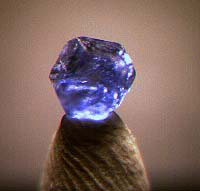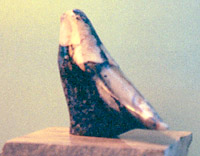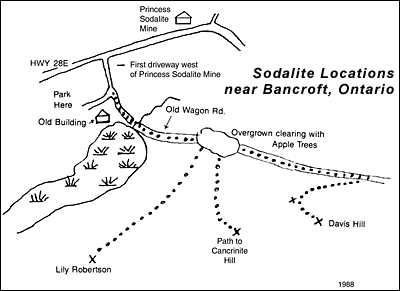 |
|||
|
|||
|
Copyright Sodalite: A Rare Silicate Mineral BY MARILYN FRASER
Frank D. Adams first discovered the deposit near Bancroft about 1892 while investigating the geology of the Haliburton-Hastings area for the Geological Survey of Canada. In 1893 a rough specimen was shown in the Ontario Provincial exhibit of the World's Columbian Exposition in Chicago. The Geological Survey of Canada also displayed cut and polished specimens at the Exposition.
In certain types of silica-poor igneous rocks, the feldspars are replaced by a special group of minerals, the feldspathoids. Feldspathoids are nepheline and sodalite. They are not common. The finer-grained varieties are found in dykes and sills. Sodalite is found in regions where volcanic action was responsible for nepheline rocks being invaded from below by sodium chloride. This is what gives the mineral its deep blue colour. The blue colour is very typical of this mineral and can be confused with lazulite and lazurite. On heating, sodalite loses colour and fuses to white glass with the strong yellow flame of sodium. The fused mineral will fluoresce blue in shortwave ultraviolet light. Hackmanite is brilliantly fluorescent without heating. This mineral has a glassy luster with a Mohs hardness of 5.5-6. The specific gravity is 2.2-2.3. Its fracture is conchoidal to uneven with a poor dodecahedral cleavage. In 1905, when the Prince and Princess of Wales visited Canada, they were presented with a piece of sodalite. The couple had such admiration for the beautiful azure blue stone with its red and white colouring that arrangements were made to ship some of it to England. Thus the Princess Sodalite Quarry was named. The name as since been changed to the Princess Sodalite Mine. 1906 saw the first commercial operation of the deposit, when Mr. Thomas Morrison employed six men to extract 200 cu. ft. (130 tons) of sodalite for use as a decorative stone. This production, valued at $6,000 was shipped to London for use in Marlborough House, for the residence of Sir Ernest Cassell, Park Lane, Hyde Park. Over the years this mine has been operated by a number of owners:
At the Goulding-Keene Quarry the deposit is about 80 ft. long by 60 ft. wide with a 40 ft. face. It is located in the side hill on the west bank of the York River. Grey nepheline and white plagioclase include deposits of blue massive sodalite. At Egan Chute sodalite occurs in irregular masses in gneiss.
References:
Copyright © 2001 Marilyn L. Fraser This article may not be copied, distributed or reprinted in any form without the author's permission. To contact the author, please use the e-mail address provided. If you are unable to contact the author, please contact the Canadian Rockhound. Authorized reprints must acknowledge the author, original source and the Canadian Rockhound, and include the website URL address of the Canadian Rockhound. The preceding article was first published in the Summer 1989 issue of Cab & Crystal (Vol. 1, No. 2). Updated December 2000. Reprinted in the Canadian Rockhound with permission from the author.
|
||||
 
Copyright © 2001 Canadian Rockhound
Back Issues |
News & Events |
Junior Rockhound
|
||||



